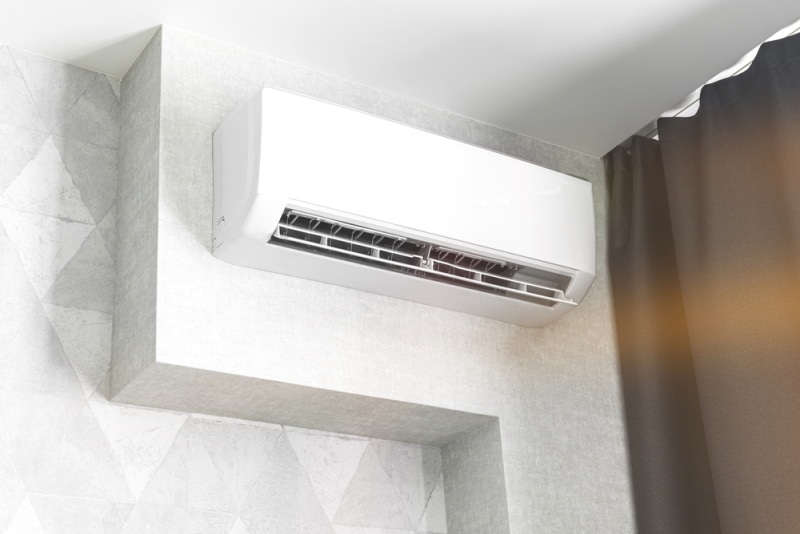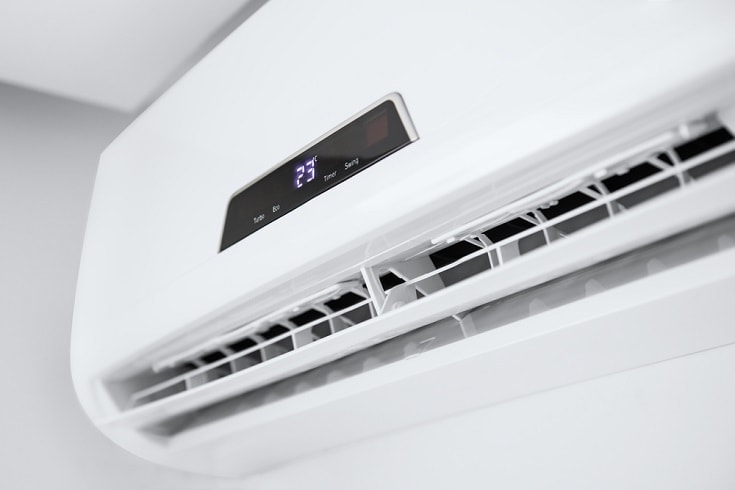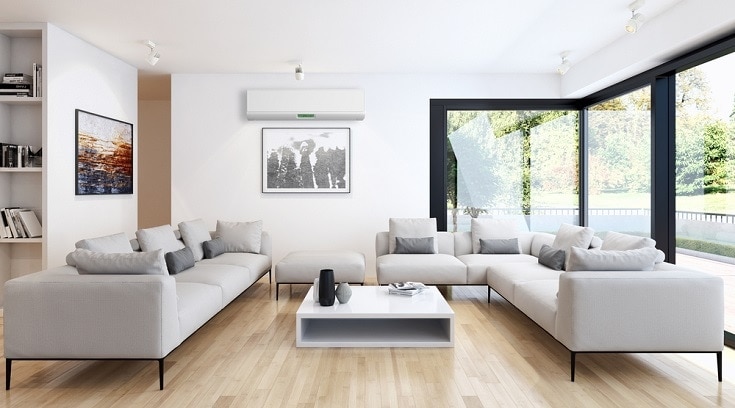Are Mini Splits Energy Efficient? Benefits, Disadvantages, & FAQ
-
Jeff Weishaupt
- Last updated:

Mini splits are cooling and heating units that don’t require any ductwork. They are very energy-efficient and can help you save money on utility bills. Mini splits are also very quiet and can be installed in almost any room in your home.
These systems have two components: an indoor evaporator and an outdoor condenser or compressor. The evaporator goes on the wall or ceiling in the room you want to cool or heat. The condenser is outside, and it pumps refrigerant to the evaporator.
Mini splits are available in various sizes and styles to suit your needs. Some units can even be installed in your attic or garage. First, let’s learn about their energy efficiency.
How Efficient Are Mini-Splits?
Mini-splits are one of the most energy-efficient ways to heat and cool your home. They are so efficient that they can save you up to 30% on your utility bills¹.
Mini splits don’t lose any energy through ductwork. Unfortunately, ductwork is responsible for losing a lot of energy in traditional heating and cooling systems.
When you have a mini split installed, you will also have an easier time maintaining a comfortable temperature in your home. In addition, you won’t have to worry about hot and cold spots because the mini split will distribute air evenly throughout the space.
Most reverse-cycle mini-split air conditioners have an efficiency of 300–600. That means they take a single thermal energy unit and turn it into multiple units of energy. The most efficient ones have an output of 600.
Mini splits are also space efficient. Unlike other add-on systems, they offer more flexibility regarding installation. You can have a mini split installed in any room, regardless of space constraints. You can also suspend them from the ceiling or mount flush them into a drop ceiling. Some models also stand on the floor.

How Do Mini-Splits Save Energy?
The ductwork in a typical central air conditioner can account for more than 30% of the energy consumption¹. Duct losses can be even higher in homes with long runs of ductwork or in poorly insulated spaces. A mini-split system doesn’t have any ducts, so it avoids those losses. How does this happen?
Central air conditioners move heat by circulating refrigerant through a closed loop between an indoor and outdoor unit. The refrigerant gathers heat from the indoor air and dumps it outdoors.
A mini-split system also uses refrigerant but circulates it through a small pipeline. One part of the system, called the evaporator, is installed inside the home near the area that needs cooling. The other part of the system, called the condenser, is installed outside.
A mini split has an advantage over a central air conditioner because it doesn’t have to repeatedly cool and reheat the same air. Instead, it can cool or heat individual rooms as needed. In addition, a mini split can be programmed to work only when needed. So, if you’re gone all day, you can set it to shut off until you come home.
Where Can You Use Mini-Splits?
Mini splits are ideal for spaces that are difficult or impossible to cool with a traditional central air conditioning system.
- Rooms over a garage
- Sunrooms and enclosed porches
- Additions
- Dens
- Attics
- Workshops
- Man caves

Mini splits can also be a good choice for rooms that are used infrequently but need to be kept cool, like a guest room.
One of the benefits of a mini-split system is that you can cool different areas of your home to different temperatures. For example, you could set the temperature in your living room to 72 degrees and keep it at 68 degrees in your bedroom.
What Are the Disadvantages of Mini-Split Systems?
Although mini-split systems have many advantages, there are a few disadvantages. Here are some of them:
Higher Upfront Cost
One of the most significant disadvantages is the initial cost. These systems can be expensive to purchase and install, especially if you need multiple units to heat and cool your home. They cost $1,500–$2,000 per ton of cooling capacity.
Additionally, mini splits require professional installation, which can add to the overall cost. Finally, you’ll have to factor in the cost of hiring an HVAC contractor to install your system.
Inadequate for Large Homes
Another potential downside is that mini-split systems may not be adequate for large homes. You’ll need multiple units to heat and cool it properly if you have a big home.
It can be expensive, both in terms of the initial purchase price and the installation cost. Additionally, it’s essential to ensure that each unit is properly sized for the space it will be cooling or heating.

Single Zone Only
Mini splits are also single-zone systems, which means they can only heat or cool one area at a time. For example, you can’t have one unit that cools the downstairs and another unit that heats the upstairs.
In a multi-level home, you’ll need a separate mini-split system for each level. Additionally, each zone will need its own thermostat, so you’ll have to factor in those costs.
Require Proper Placement
It’s imperative the installer places the mini-split unit in the right place. Incorrectly placed units can cause short cycling.
When the system cycles on and off frequently, it doesn’t have a chance to reach its full potential efficiency. That will cause your energy bills to be higher than they should be. Thus, it defeats the purpose of using a mini split in the first place.
Additionally, if the unit is placed in an area exposed to the elements, it can shorten the system’s lifespan. Likewise, if a unit is too large for an area, it will be expensive to operate.
Poor Aesthetic
Unlike central air conditioning units, mini splits are visible inside and outside the home. The indoor unit mounts on the wall or ceiling, while the outdoor unit is usually on a concrete pad next to the house. For some people, the visibility of the units is a turnoff. If you’re concerned about aesthetics, you may want to consider another type of cooling system.
Plus, it’s important to locate the unit near a drainage place. You’ll have to drain the condensate water of the outdoor unit.

How Much Does a Mini-Split Cost Per Month?
It can cost you $12–$500¹ to heat or cool a single room with a mini-split, depending on the size of the space, the efficiency of the unit, and how much heat or cool you need. In most cases, a mini-split costs $100 a month.
Can Mini Splits Heat or Cool the Whole House?
No, a mini split is not designed to heat or cool an entire house. They are best used in specific rooms or areas that need targeted temperature control.
For instance, you can use a mini split to cool a sunroom that gets too hot in the summer or to heat a finished basement that’s always cold. You can also use multiple mini splits to control the temperature in different areas of your home.
Conclusion
Mini-split systems are pretty efficient and can be a great option for those wanting to improve their home’s energy efficiency. If you are considering a mini-split system, make sure to do your research and find a reputable contractor to install it.
- https://www.crownpower.com.au/blog/are-split-systems-expensive-to-run-for-heating/
- https://learnmetrics.com/how-much-does-it-cost-to-run-a-mini-split/
- https://www.newenglandductless.com/blog/are-mini-splits-energy-efficient/#:~:text=A%20mini%2Dsplit%20system%20is,ability%20to%20operate%20without%20ductwork.
- https://www.energy.gov/energysaver/ductless-mini-split-air-conditioners
Featured Image Credit: FellowNeko, Shutterstock
Contents
